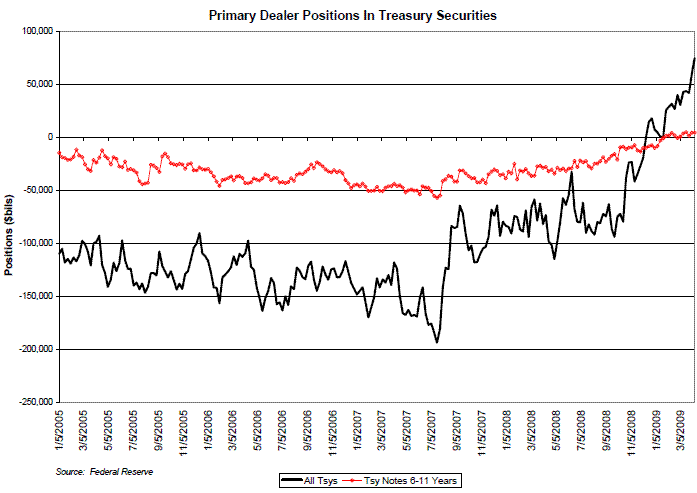In last week's entry, I wrote that mortgage rates should be headed lower, and that I expect them to move below 4.5% by the end of the summer. While I stand by that assessment, it's always a good practice to try and understand what might happen to upset a prediction. Put differently, it's useful to consider what assumptions are being made, and contemplate what events and/or factors might cause a forecast to be completely off base. This is particularly true when the consensus of opinion falls overwhelmingly in one direction.
My expectations for mortgage rates are based on the assumption that the Fed will have both the will and the means to keep intermediate and long Treasury rates low by buying Treasuries. By undertaking the program to purchase Treasuries (as well as agency debentures and MBS), the Fed is essentially funding the national deficit by increasing the monetary base (or, to put it inelegantly, "printing money"). As one would expect, traders and investors have anticipated the actual Fed purchases by increasing their positions in U.S. Treasury securities. This has kept 10-year Treasury yields remain below 3% despite the prospect of humongous long-term deficits and resulting inflationary pressures.
That "someone" is, at least in part, the Primary Dealer community, or those Wall Street firms that are allowed to deal directly with the Federal Reserve. The below chart shows data from the Federal Reserve on net Primary Dealer positions in both total Treasuries and Treasury notes with maturities between six and eleven years. As of April 8th, net Treasury positions were, at roughly $75 billion, the largest on record (going back to 1997). By contrast, primary dealers had net positions of negative $193 billion as recently as the summer of 2007.

It's also interesting to see that the Primaries have positive net positions in intermediate-maturity Treasuries. Until recently, this was quite rare. Large dealers typically carry negative ("short") positions in these securities, presumably to hedge their interest rate exposure to other fixed-income asset classes (such as MBS and corporate bonds).
The firms have taken these unusual positions with the expectation that the Fed's activities will push prices on intermediate- and long-term Treasuries higher. Their underlying assumption is that the Fed has both the means and the will to carry out their stated intentions. While I have no doubt that the Fed has the ability to expand their balance sheet significantly, they have been known to change their collective mind. If Fed officials (from Chairman Bernanke on down) make any statement or comment that calls these purchases into question, the effect could be like that of a crowd trying to escape a burning department store through revolving doors; the firms would all try to exit (or hedge) losing positions at the same time. This would serve to push intermediate and long Treasury rates sharply higher. Another possibility is that some economic event (such as a major jump in inflation rates) could trigger a selloff that would overwhelm the Fed's efforts to support the market.
A significant bond market selloff would precipitate a related phenomenon that would put added upward pressure on rates. Since the durations (i.e., the price sensitivity) of mortgage-backed securities are strongly influenced by prepayments, higher interest rates (which will cause prepayment rates or "speeds" to slow) typically mean that MBS investors are seeing their portfolios getting "longer" at precisely the time they would want to stay "short." The prospect of lengthening portfolio durations in a selloff normally forces portfolio managers to sell securities into the already weak market, pushing prices even lower. This is the dreaded "negative convexity" in action. Over the past 10-15 years, as the MBS markets grew to be the largest single segment of the bond market, moves in the rates markets have been exacerbated by this type of convexity-related "duration shedding."
I don't put a high likelihood on this scenario, as I believe that the Fed is committed to holding down long rates in order to support the housing markets. If I had to put odds on it, I'd call it one chance in six. A more likely scenario, as I see it, will be for intermediate rates to move within a fairly narrow band; a 10-year yield above 3.10% will probably bring aggressive buying from the Fed that should stem further rate increases and allow mortgage rates to eventually move to the 4.5% area.
However, it would be foolish to pretend that the rising rate scenario I've described couldn't happen. If nothing else, it's correct to be wary when the consensus of opinion falls overwhelmingly on one side of a question. To quote a great American (John Wooden), "failing to prepare is preparing to fail." Mortgage market players should at least be ready to jettison bad positions if the 10-year Treasury moves past the area of 3.15%.





